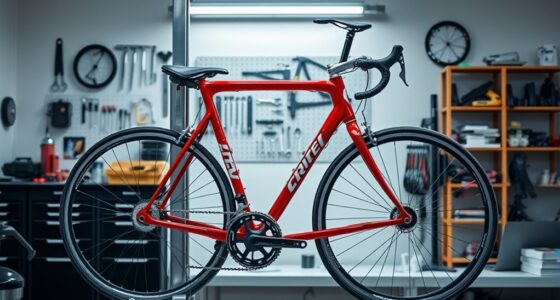If you’re aiming for stunning photos in 2025, I recommend exploring a mix of prime and zoom lenses suited for different scenarios, from portraits to wildlife. Professional photographers favor lenses like the Canon EF 50mm f/1.8 STM for beautiful backgrounds and Nikon’s 55-300mm options for distant subjects. Choosing the right lens depends on your camera, light conditions, and style. If you continue, you’ll discover essential tips to find the perfect fit for your photography goals.
Key Takeaways
- Professional-recommended lenses offer superior image quality, sharpness, and color accuracy suitable for stunning photos in 2025.
- Versatile zoom and prime lenses facilitate creative compositions across various genres like portraits, landscapes, and macro.
- Modern lenses feature advanced stabilization and silent autofocus technologies for sharp, blur-free images and smooth video.
- Budget-friendly options provide excellent performance for beginners and hobbyists aiming for professional-looking results.
- Compatibility with current DSLR models and durable build quality ensure longevity and consistent high-quality output.
Canon EF 50mm f/1.8 STM Lens

If you’re looking for an affordable yet high-quality lens that’s perfect for beginners and casual shooters, the Canon EF 50mm f/1.8 STM stands out as an excellent choice. It’s compact, lightweight, and offers a bright f/1.8 aperture, ideal for low-light situations and creating beautiful background blur. The lens features a sturdy metal mount, quick autofocus with near-silent STM technology, and a minimum focusing distance of just 1.15 feet. Its sharp images, natural perspective, and affordability—around $125—make it a versatile option for portraits, street photography, and everyday use. This lens truly balances performance and value for any photographer starting out.
Best For: beginners and casual photographers seeking an affordable, versatile lens for portraits, street, and low-light photography.
Pros:
- Compact and lightweight, easy to carry around all day
- Bright f/1.8 aperture ideal for low-light conditions and creating beautiful background blur
- Near-silent autofocus with STM technology suitable for both stills and video
Cons:
- Fixed 50mm focal length may be limiting for wide-angle or macro shots
- Build quality, while improved over older models, still feels less robust than professional lenses
- Autofocus performance can vary on older or less advanced Canon camera bodies
Canon EOS Rebel T7 DSLR Camera Kit with 2 Lenses (EF18-55mm + EF75-300mm)
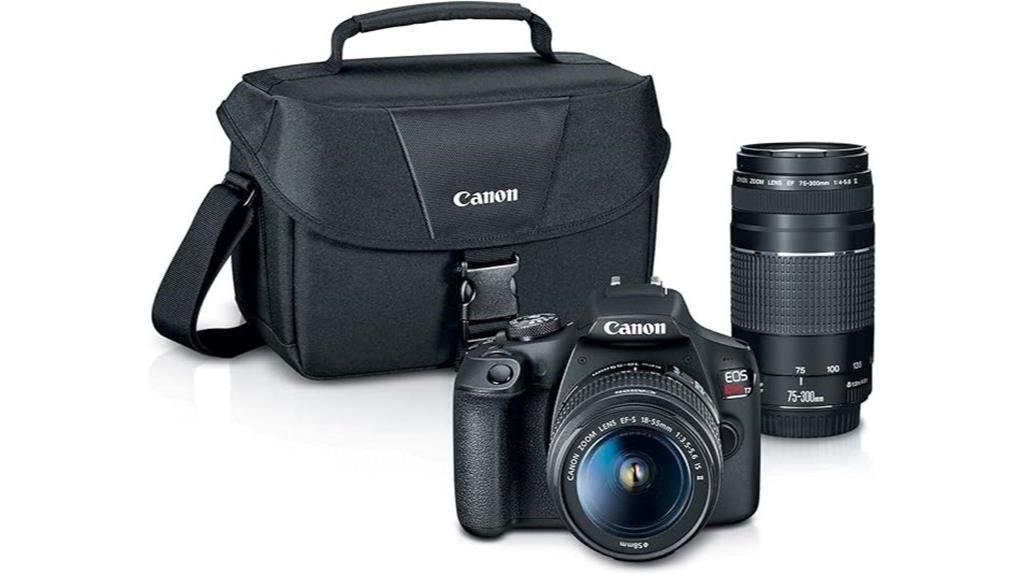
The Canon EOS Rebel T7 DSLR Camera Kit with 2 lenses is an excellent choice for beginners seeking an easy-to-use yet versatile camera. Its 24.1 MP APS-C sensor captures sharp, vibrant photos even in low light. The improved autofocus features, including Dual Pixel CMOS AF and eye detection AF, ensure precise focus, while the 9-point AF system tracks moving subjects effectively. The kit’s two lenses—EF18-55mm and EF75-300mm—cover a wide range of shooting scenarios, from wide landscapes to distant subjects. Built-in Wi-Fi and NFC make sharing simple, and the intuitive auto modes help newcomers achieve professional-looking shots effortlessly.
Best For: Beginners and amateur photographers seeking an easy-to-use, versatile DSLR camera for capturing high-quality photos and videos in various settings.
Pros:
- 24.1 MP APS-C sensor delivers sharp, vibrant images with good low-light performance
- Includes two versatile lenses (EF18-55mm and EF75-300mm) for wide-angle and telephoto shots
- Built-in Wi-Fi and NFC facilitate quick sharing and remote control via smartphones
Cons:
- Limited to a 9-point autofocus system, which may be less advanced than higher-end models
- No 4K video recording, only Full HD 1080p at 60fps
- Slightly bulkier compared to compact mirrorless or point-and-shoot cameras
Nikon AF-S DX NIKKOR 55-300mm f/4.5-5.6G ED Zoom Lens

Photographers seeking an affordable, versatile telephoto lens will appreciate the Nikon AF-S DX NIKKOR 55-300mm f/4.5-5.6G ED, especially for capturing distant subjects with sharpness and stability. This 5.5x zoom lens offers a focal length range of 55-300mm, ideal for wildlife, sports, and travel photography. Its built-in Nikon VR (Vibration Reduction) stabilizes images, while the Silent Wave Motor ensures quiet, fast autofocus. Weighing just 1.28 pounds, it’s portable and easy to handle. With a minimum focus distance of 4.6 feet and advanced ED elements, this lens combines affordability with reliable performance for enthusiasts and pros alike.
Best For: amateur and professional photographers seeking an affordable, versatile telephoto lens for wildlife, sports, travel, and distant subject photography.
Pros:
- Excellent 5.5x zoom range (55-300mm) for versatile shooting options
- Built-in Nikon VR (Vibration Reduction) for stable handheld shots
- Quiet and fast autofocus thanks to Silent Wave Motor (SWM)
Cons:
- Aperture range of f/4.5-5.6 may limit low-light performance
- Slightly heavier than some comparable compact telephoto lenses at 1.28 pounds
- Minimum focus distance of 4.6 feet may restrict close-up macro capabilities
EF 85mm f1.8 Portrait Lens for Canon DSLR Cameras
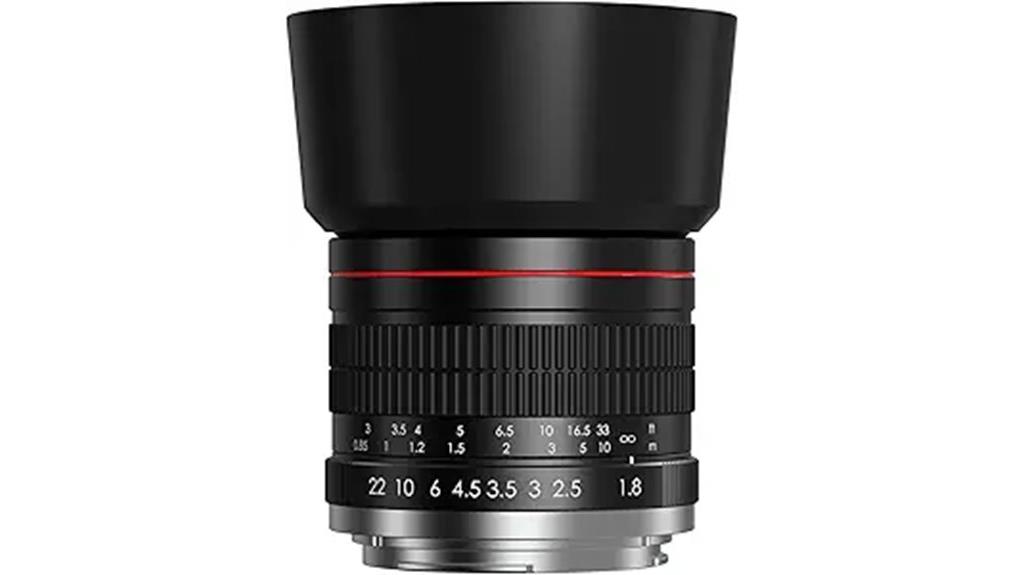
For those seeking precise control over their portrait shots, the EF 85mm f1.8 Portrait Lens stands out as an excellent choice. Designed for Canon EOS DSLR cameras, it offers compatibility with EF and EF-S mounts, making it versatile for various models. This fully manual lens provides sharp details, beautiful bokeh, and minimal aberrations thanks to its hybrid aspherical lens and UMC coating. Its internal focus mechanism ensures quiet, fast operation, while manual focus allows for fine-tuned adjustments. Ideal for artistic and professional portraits, this lens encourages creative control and artistic expression, elevating your photography with clarity and stunning background separation.
Best For: photographers seeking precise manual control and artistic flexibility for portrait photography with high-quality image rendering.
Pros:
- Sharp details and excellent background blur (bokeh) for stunning portraits
- Minimal aberrations and glare due to hybrid aspherical lens and UMC coating
- Quiet, fast internal focus mechanism enhances shooting experience
Cons:
- Fully manual focus may be challenging for beginners or quick shots
- Lacks electronic contacts, limiting compatibility with some camera features
- Requires camera to be set to full manual mode to prevent lens errors
Nikon AF-S DX NIKKOR 18-140mm f/3.5-5.6G ED Zoom Lens for Nikon DSLR

If you’re seeking a versatile lens that covers a wide range of shooting scenarios, the Nikon AF-S DX NIKKOR 18-140mm f/3.5-5.6G ED is an excellent choice for Nikon DSLR users. It offers a broad zoom range from 18mm wide-angle to 140mm telephoto, perfect for landscapes, portraits, and travel shots. Its optical design includes ED and aspherical elements, reducing chromatic aberration for sharp images. With Nikon’s Silent Wave Motor, autofocus is fast and quiet, while vibration reduction ensures stability in handheld shots. Built with durable coatings and a solid construction, this lens is ideal for everyday photography and videography.
Best For: photography enthusiasts and travelers seeking a versatile, all-in-one lens for capturing landscapes, portraits, and everyday moments with their Nikon DSLR.
Pros:
- Wide zoom range from 18mm to 140mm, suitable for various shooting scenarios
- Smooth, fast, and quiet autofocus thanks to Nikon’s Silent Wave Motor
- Effective vibration reduction for sharp images in low-light and handheld conditions
Cons:
- Variable aperture (f/3.5-5.6) may limit low-light performance compared to prime lenses
- Slightly bulkier and heavier than standard kit lenses
- Not ideal for extreme macro or specialized photography needs
Nikon AF-S DX NIKKOR 18-105mm f/3.5-5.6G ED Zoom Lens for Nikon DSLR Cameras

The Nikon AF-S DX NIKKOR 18-105mm f/3.5-5.6G ED zoom lens stands out as an excellent choice for enthusiasts seeking versatility in their photography. Designed for Nikon DX-format DSLR cameras, it offers a 5.8x zoom suitable for portraits, landscapes, and action shots. With Vibration Reduction technology, it helps capture sharp images even in low light or handheld scenarios. Its compact size and lightweight design make it ideal for everyday use. Praised for its affordability and image quality, this lens is a reliable upgrade from kit lenses, providing flexibility across a wide range of photographic styles.
Best For: amateur and enthusiast photographers seeking a versatile, affordable zoom lens for everyday photography on Nikon DX-format DSLR cameras.
Pros:
- Offers a broad 5.8x zoom range suitable for various photography styles including portraits, landscapes, and action shots
- Equipped with Vibration Reduction technology for sharper handheld images in low light conditions
- Compact and lightweight design enhances portability and ease of use
Cons:
- Some users report focus locking or zoom mechanism issues over time, especially on used or older lenses
- May have slightly lower build quality and durability compared to higher-end lenses, with some preferring metal mounts
- Warranty coverage can be limited if purchased from non-authorized dealers, potentially leading to higher repair costs
Nikon 55-200mm f/4-5.6G ED-IF AF-S DX VR Lens
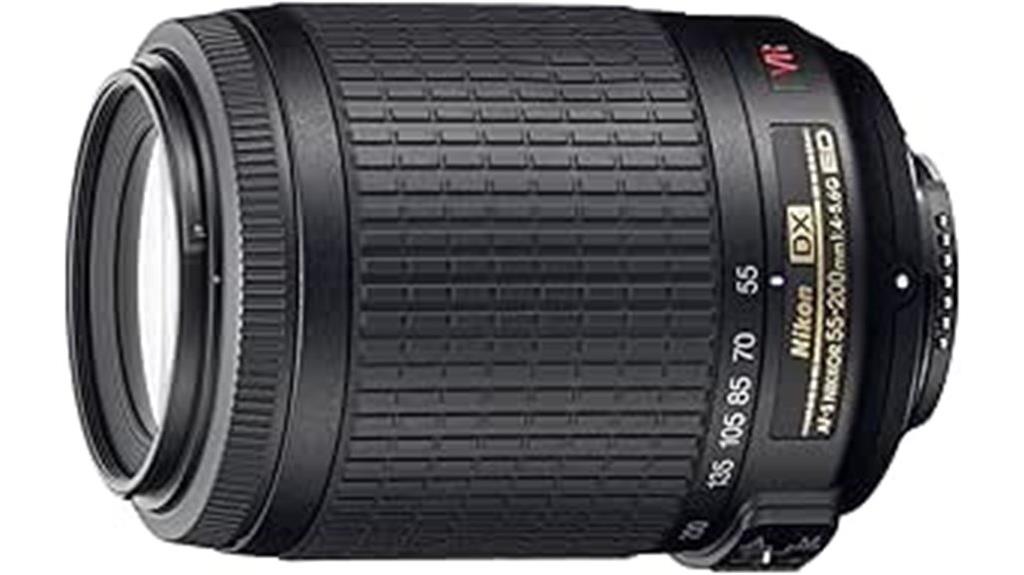
Capturing sharp, steady shots at a distance becomes effortless with the Nikon 55-200mm f/4-5.6G ED-IF AF-S DX VR Lens, making it an ideal choice for photographers who want versatile zoom capabilities without sacrificing portability. Weighing only 9 ounces and measuring just over 3 inches long, it’s easy to carry everywhere. Its optical design includes extra-low-dispersion glass elements that minimize chromatic aberration, ensuring crisp images. The silent autofocus, combined with vibration reduction technology, helps you shoot quickly and smoothly, even in low light. Perfect for travel and outdoor photography, this lens offers excellent value and superior image quality in a compact package.
Best For: photographers seeking a lightweight, versatile zoom lens for travel and outdoor photography with superior image quality and stabilization.
Pros:
- Compact and lightweight design weighing only 9 ounces for easy portability
- Contains ED glass elements that minimize chromatic aberration for crisp images
- Equipped with Vibration Reduction and silent autofocus for steady, quiet shooting
Cons:
- Maximum aperture of f/4-5.6 may limit performance in very low light conditions
- Built-in plastic construction might be less durable over time
- Bulk packaging and lack of additional accessories could require extra purchases
Canon EF-S 55-250mm F4-5.6 is STM
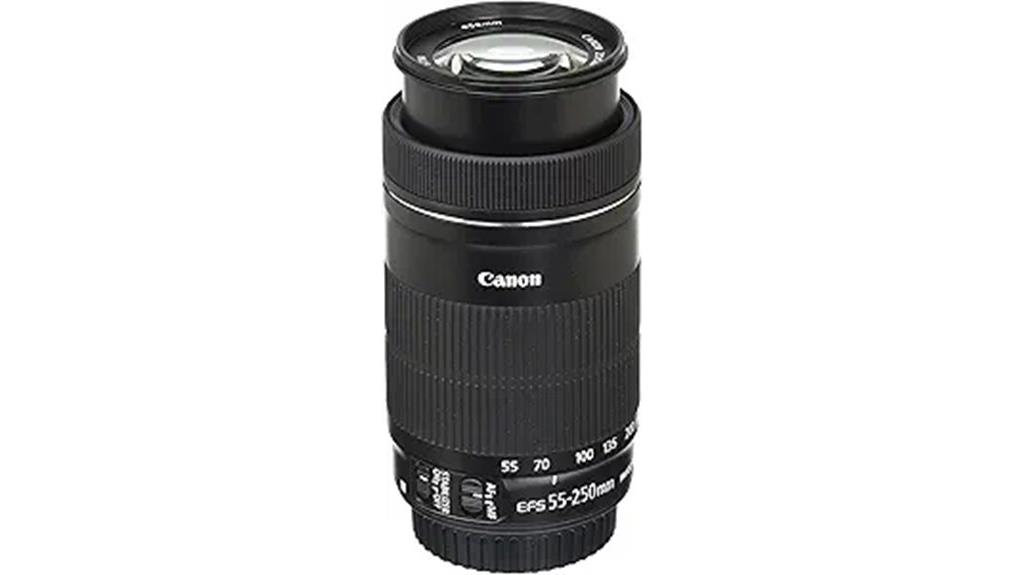
For photographers seeking an affordable yet versatile telephoto zoom lens, the Canon EF-S 55-250mm F4-5.6 IS STM stands out as an excellent choice. This compact, lightweight lens offers up to 0.29x magnification, perfect for capturing distant subjects like wildlife or sports. Its high-quality optics include a UD element that reduces chromatic aberration, ensuring sharp, vibrant images. With built-in image stabilization providing 3.5 stops of shake correction and quiet autofocus thanks to Canon’s STM technology, it’s ideal for both photography and videography. Plus, its non-rotating front element makes filter use easy. Overall, it’s a reliable, budget-friendly option for versatile outdoor shooting.
Best For: amateur photographers and hobbyists seeking an affordable, versatile telephoto lens for wildlife, sports, and outdoor photography.
Pros:
- Compact, lightweight design for easy portability and handling
- Effective 3.5 stops of image stabilization for sharp handheld shots
- Quiet autofocus with smooth operation, ideal for videography
Cons:
- F4-5.6 aperture limits low-light performance compared to faster lenses
- Maximum magnification of 0.29x may not be sufficient for extreme macro photography
- Build quality and durability may be less robust than professional-grade lenses
Nikon 55-300mm f/4.5-5.6G ED Vibration Reduction Zoom Lens for Nikon DSLR

If you’re looking to expand your telephoto reach without breaking the bank, the Nikon 55-300mm f/4.5-5.6G ED Vibration Reduction Zoom Lens offers impressive versatility for Nikon DSLR users. This certified refurbished lens features a 5.5x zoom, equivalent to 82.5-450mm in full-frame terms, perfect for wildlife, sports, or distant landscapes. It includes advanced optics like ED glass and HRI elements for sharp images, plus Nikon’s VR II stabilization for steady handheld shots. Quiet autofocus with SWM and tripod detection mode enhance usability. Weighing just over 0.32 ounces, it’s lightweight for its zoom range, making it a reliable, cost-effective choice for capturing distant subjects.
Best For: amateur and enthusiast photographers seeking an affordable, versatile telephoto zoom lens for wildlife, sports, and travel photography with Nikon DSLR cameras.
Pros:
- Excellent zoom range equivalent to 82.5-450mm for capturing distant subjects
- Advanced optical elements like ED and HRI for sharp, high-contrast images
- Built-in Nikon VR II stabilization and quiet autofocus for handheld shooting and video
Cons:
- Slight focus hunting in low light conditions
- Internal dust or smudges may be present in refurbished units, affecting image quality
- Heavier than some comparable lenses, which may impact extended handheld use
58MM Altura Photo HD Wide Angle Lens with Macro for Canon DSLR Cameras

The MM Altura Photo HD Wide Angle Lens with Macro is an excellent choice for photographers seeking versatility and high-resolution close-ups with their Canon DSLR cameras. This 58MM lens screws onto compatible lenses, expanding the field of view for stunning wide-angle shots and includes a detachable macro feature for detailed close-ups of small objects. It’s compatible with popular Canon models like the Rebel series and 80D, making it highly versatile. With a 0.43x wide-angle and macro functionality, it’s perfect for landscape, architecture, and macro photography. Customer ratings are strong, and it offers excellent value for those wanting to enhance their Canon DSLR kit.
Best For: photographers using Canon DSLR cameras seeking to expand their wide-angle capabilities and capture high-resolution macro shots.
Pros:
- Expands field of view for wide-angle photography, perfect for landscapes and architecture.
- Includes a detachable macro lens for detailed close-ups of small objects.
- Compatible with a wide range of Canon DSLR lenses and models, offering versatility.
Cons:
- Requires verifying lens thread size (58MM) before purchase to ensure compatibility.
- Adds extra weight and bulk to the camera setup.
- May introduce slight distortion or vignetting at the edges in wide-angle shots.
Canon EF 75-300mm f/4-5.6 III Telephoto Zoom Lens for Canon SLR Cameras

Budget-conscious photographers seeking versatile telephoto coverage will find the Canon EF 75-300mm f/4-5.6 III an excellent choice. This affordable lens offers a focal range of 75-300mm, perfect for capturing distant wildlife, portraits, and outdoor scenes. While it lacks image stabilization and has slower autofocus, it delivers sharp images at 75mm and 200mm, especially in good lighting. Its macro-like focusing allows close-up shots of small subjects. Built with durability in mind, it’s lightweight and compatible with Canon’s accessories. Ideal for beginners, it offers great value for casual photography, wildlife observation, and learning telephoto techniques.
Best For: beginner and casual photographers seeking an affordable telephoto lens for wildlife, portraits, and outdoor photography.
Pros:
- Good image quality at 75mm and 200mm focal lengths in well-lit conditions
- Durable build and lightweight design for easy handling
- Compatibility with Canon accessories like close-up lenses for macro shots
Cons:
- No image stabilization, requiring tripod or high ISO settings for sharp images
- Slower autofocus, especially in low light or at longer focal lengths
- Reduced sharpness and image quality at 300mm, particularly when cropping
Nikon AF-P DX NIKKOR 70-300mm f/4.5-6.3G ED VR Lens for Nikon DSLR Cameras
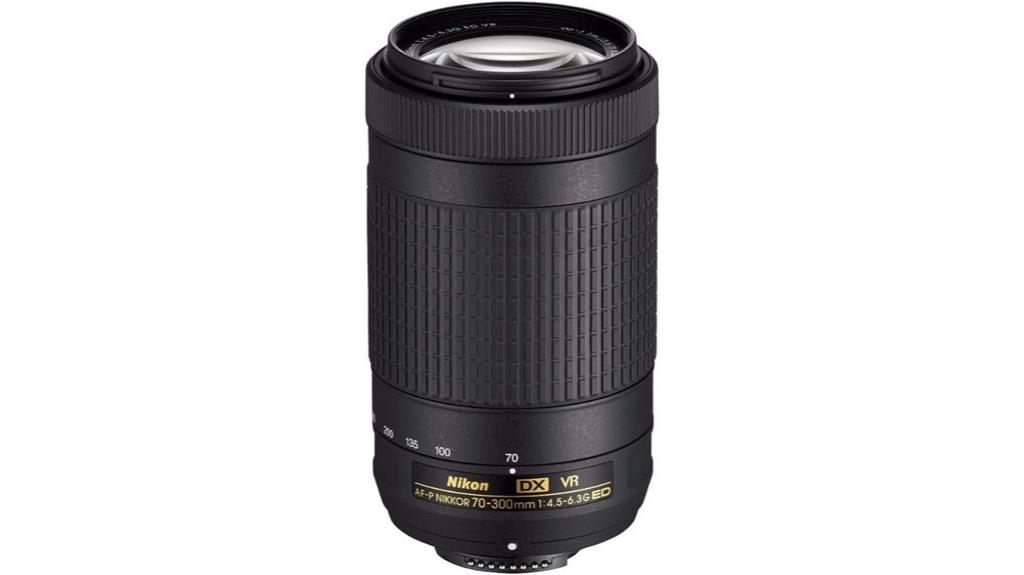
Looking for a versatile telephoto lens that can capture distant subjects with clarity? The Nikon AF-P DX NIKKOR 70-300mm f/4.5-6.3G ED VR Lens is perfect for this. It’s compact, lightweight, and offers a 70-300mm focal length, making it ideal for wildlife, sports, and travel photography. With Nikon’s VR image stabilization and quiet autofocus, you get sharp, blur-free shots even handheld. Its high-quality optics include an ED glass element to minimize aberrations. Compatible with many Nikon DX cameras, it’s a reliable choice to extend your zoom range and capture stunning images with precision and ease.
Best For: photographers seeking a lightweight, versatile telephoto zoom lens for wildlife, sports, travel, and portrait photography with sharp image quality and effective stabilization.
Pros:
- Compact and lightweight design for easy handling and portability
- Nikon VR image stabilization for blur-free handheld shots
- Quiet autofocus with stepping motor technology ideal for videos and quick shooting
Cons:
- Variable aperture range of f/4.5-6.3 may limit low-light performance
- Compatibility limited to Nikon DX-format DSLR cameras, requiring firmware updates for some models
- Not suitable for full-frame Nikon cameras or professional-grade photography requiring wider apertures
Nikon AF-S DX NIKKOR 18-140mm f/3.5-5.6G ED Vibration Reduction Zoom Lens for Nikon DSLR Cameras

If you’re seeking a versatile lens that covers a wide range of shooting scenarios, the Nikon AF-S DX NIKKOR 18-140mm f/3.5-5.6G ED VR stands out as an excellent choice. Its 7.8x zoom range lets me capture everything from wide landscapes to detailed close-ups, perfect for on-the-go shooting. The lens’s sharp optics, enhanced by ED glass, ensure clear images, while the 4-stop Vibration Reduction stabilizes handheld shots in low light. Compact and lightweight, it’s ideal for travel and everyday use. Plus, the silent autofocus keeps my videos smooth. Overall, it’s a reliable, all-in-one lens for versatile photography.
Best For: photographers and videographers seeking a versatile, all-in-one zoom lens suitable for a wide range of shooting scenarios, from landscapes to close-ups.
Pros:
- 7.8x zoom range (18-140mm) offers excellent versatility for various subjects and compositions
- Equipped with Nikon’s Vibration Reduction (VR) for sharp handheld shots in low light or at telephoto lengths
- Compact, lightweight design makes it ideal for travel, daily use, and on-the-go photography
Cons:
- Variable aperture (f/3.5-5.6) may limit performance in very low-light conditions without additional support
- Factory-refurbished status might concern some users regarding long-term durability, despite warranty coverage
- Not a professional-grade lens, so it may not meet the needs of high-end or specialized photography requirements
Telephoto Lens for Nikon DSLR
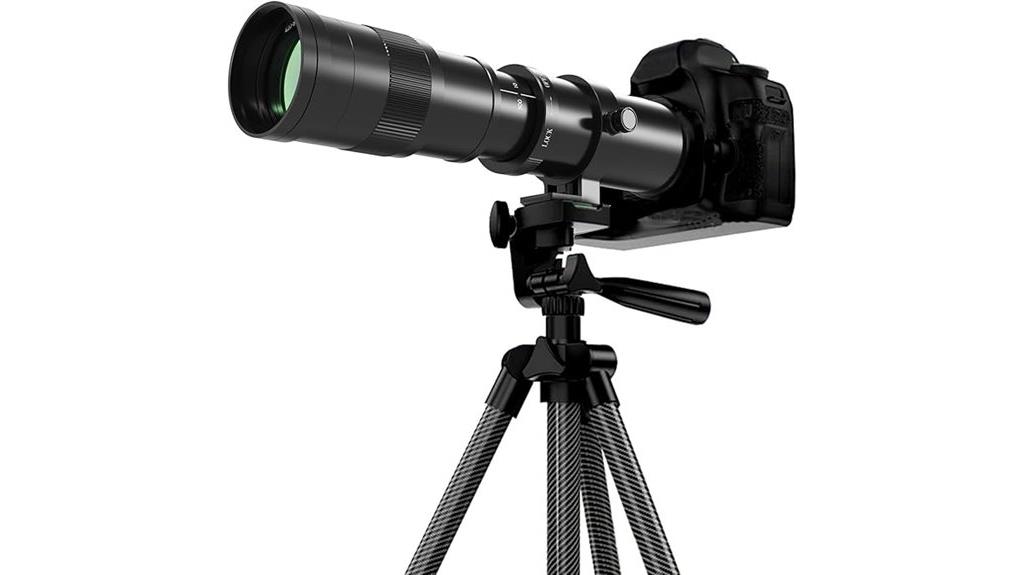
The telephoto lens for Nikon DSLR is an excellent choice for photographers who want to capture distant subjects with precision. Compatible with Nikon F-mount DSLR cameras, it fits models from the D-series and film cameras alike. With a focal length of 420-800mm and a fixed aperture of F/8.3-16, it’s perfect for wildlife, moon, and faraway shots. This manual focus lens requires setting your camera to manual mode, as it lacks autofocus and electronic contacts. Built from durable materials, it’s designed for outdoor use. While it demands manual operation, it offers excellent image quality for those comfortable with manual focusing.
Best For: hobbyist wildlife, moon, and distant object photographers who are comfortable with manual focus and want a durable, long-range telephoto lens for Nikon DSLR cameras.
Pros:
- Compatible with a wide range of Nikon F-mount DSLR and film cameras, including full-frame models.
- High-quality construction designed for outdoor and long-distance photography.
- Fixed focal length of 420-800mm provides excellent reach for distant subjects.
Cons:
- Manual focus only; no autofocus or electronic contacts, requiring manual operation.
- Non-adjustable aperture fixed at F/8.3-16, limiting exposure flexibility.
- Needs manual setting of ISO and shutter speed, as electronic communication is absent.
Nikon 35mm f/1.8G AF-S DX Lens for Nikon DSLR Cameras (Renewed)

For photographers on a budget who want reliable image quality, the Nikon 35mm f/1.8G AF-S DX Lens (Renewed) offers an excellent balance of affordability and performance. It’s compact, lightweight, and delivers sharp images, especially in low to medium light. The silent autofocus and rounded aperture blades create beautiful bokeh, perfect for portraits and street photography. While autofocus can be slightly slow and occasionally buggy on refurbished units, manual focus switching is quick and easy. Suitable for Nikon crop sensors and compatible with mirrorless cameras via FTZ adapter, it’s a versatile, value-packed lens for hobbyists, educators, and casual shooters.
Best For: budget-conscious photographers, hobbyists, and educators seeking reliable, compact prime lens performance for Nikon DSLR and mirrorless cameras.
Pros:
- Delivers sharp, high-quality images with good color accuracy and flare reduction.
- Compact, lightweight design makes it easy to carry and handle.
- Features silent autofocus and quick manual focus switching, suitable for both photography and videography.
Cons:
- Autofocus can be slightly slow and occasionally buggy, especially on refurbished units.
- Not compatible with screw-on filters due to lack of lens threading.
- Exterior wear and missing accessories (like lens hood) may be present in refurbished models.
Factors to Consider When Choosing Dslr Lenses
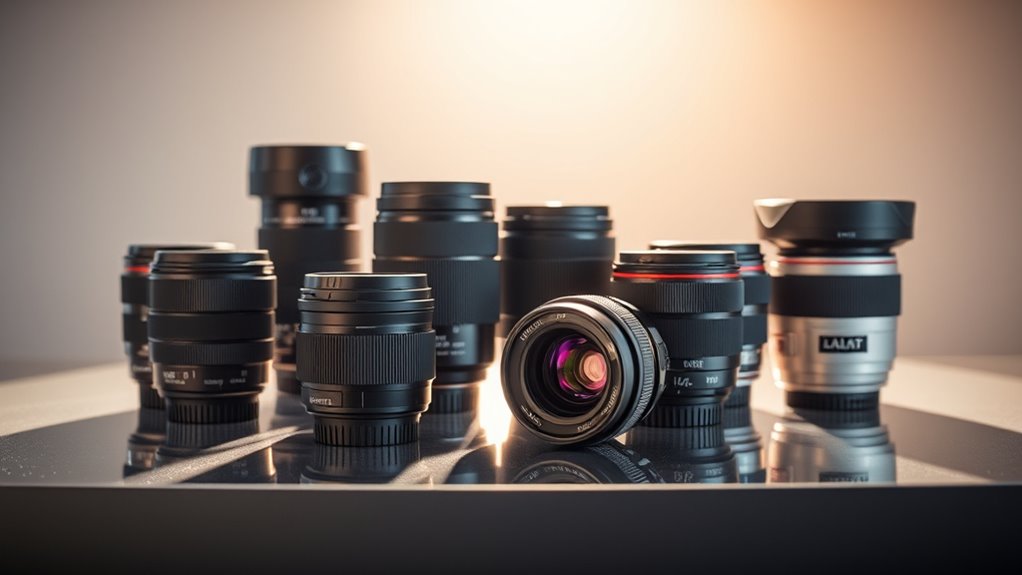
When choosing a DSLR lens, I consider compatibility with my camera body and whether the focal length suits my shooting style. I also look at the aperture to guarantee good light gathering and the autofocus performance for sharp images. Finally, I weigh the benefits of image stabilization to help in low-light conditions or when using slower shutter speeds.
Lens Compatibility Requirements
Choosing the right DSLR lens depends heavily on guaranteeing compatibility with your camera system. First, check that the lens mount type matches your camera, such as Canon EF, EF-S, Nikon F, or Sony E-mount. Next, verify that the lens works with your sensor size—full-frame or APS-C—to get the intended field of view. It’s also essential to confirm whether the lens supports your camera’s autofocus and stabilization features, especially on mirrorless models. Make sure the electronic contacts are compatible to enable auto-focus, aperture control, and metadata transfer. Lastly, review manufacturer specifications and firmware requirements to avoid compatibility issues with your specific camera model. Taking these steps ensures smooth operation and maximum performance with your DSLR.
Focal Length Suitability
The focal length of a lens directly influences your camera’s field of view and how you frame your shots. Shorter focal lengths, like 18-55mm, give you wide-angle coverage, perfect for landscapes and group photos. Medium focal lengths around 50mm offer a natural perspective, making them versatile for everyday photography and portraits. Longer focal lengths, such as 70-300mm, are great for capturing distant subjects like wildlife or sports, thanks to their telephoto reach. Lenses with focal lengths below 35mm exaggerate perspective and are ideal for emphasizing foreground objects or vast scenes. Conversely, lenses above 85mm create a compressed perspective, excellent for isolating subjects and achieving shallow depth of field. Selecting the right focal length depends on your subject, style, and how you want to frame your images.
Aperture and Light Gathering
A lens’s aperture plays a crucial role in how much light it can gather, directly affecting your camera’s ability to perform well in different lighting conditions. A larger maximum aperture, like f/1.4 or f/1.8, lets in more light, making it ideal for low-light situations and night photography. It also produces a shallow depth of field, creating beautiful background blur (bokeh) that emphasizes your subject. The aperture size influences exposure settings—wider openings mean you can use lower ISO or slower shutter speeds, reducing noise and motion blur. Additionally, lenses with a constant aperture maintain consistent light gathering across the zoom range, giving you reliable exposure control. The number of aperture blades affects the shape of out-of-focus highlights, impacting your image’s overall aesthetic.
Autofocus Performance Needs
Autofocus performance is a critical factor to contemplate when selecting DSLR lenses, especially if you need sharp images of fast-moving subjects or operate in dynamic environments. The lens motor technology plays a big role here; USM and STM motors deliver faster, quieter focusing than older screw-drive systems. For sports, wildlife, or action photography, high-speed autofocus is essential to freeze motion without delay. The number and arrangement of focus points also matter, as they influence tracking accuracy and how quickly you can acquire your subject. Keep in mind that low-light conditions can hinder autofocus speed and precision, especially with lenses lacking advanced motors or AF assist features. Additionally, compatibility with your camera body is crucial, as some lenses require firmware updates or specific motor types for optimal performance.
Image Stabilization Benefits
Image stabilization (IS) considerably enhances the quality of your photos by counteracting camera shake, especially in challenging shooting conditions. It allows me to shoot at slower shutter speeds without sacrificing sharpness, which is essential in low-light situations. IS compensates for small movements during handheld shooting, drastically reducing motion blur and resulting in clearer images. Lens-based stabilization typically offers 3 to 5 stops of correction, enabling me to capture sharp photos without a tripod. It’s also invaluable for video recording, as it keeps footage smooth by minimizing jitters caused by hand movements. Overall, effective image stabilization extends the versatility of my lenses, making them reliable across various environments—particularly for telephoto and macro photography—where stability is often hard to maintain.
Build Quality Durability
Choosing a DSLR lens that can withstand tough conditions starts with evaluating its construction quality. I look for lenses with robust metal mounts, which resist wear and keep alignment intact over time. Weather-sealing features like rubber gaskets are essential to prevent dust and moisture from getting in, especially when shooting outdoors. Durable lenses often use high-grade materials, such as reinforced plastics and hardened glass elements, adding to their longevity and impact resistance. A sealed lens barrel and sturdy focusing mechanisms ensure consistent performance in challenging environments. I also value lenses that undergo rigorous testing and strict quality control, guaranteeing reliability. Prioritizing build quality means I can confidently shoot in diverse conditions without worrying about damage or performance issues, making my investment more worthwhile.
Price and Budget Constraints
Setting a clear budget is essential when selecting a DSLR lens because it helps narrow down options and prevents overspending on unnecessary features. DSLR lenses vary widely in price, from budget-friendly $100 options to professional lenses costing thousands. Your budget influences the lens type you choose, whether it’s a basic kit lens or a used telephoto. Keep in mind that more affordable lenses might have limitations like slower autofocus, fewer optical elements, or lower durability, but they can still produce good results if chosen wisely. Balancing cost with the features you need ensures you get a lens that offers solid optical quality and performance without breaking the bank. Knowing your financial limits helps you make smarter, more satisfying purchases.
Versatility for Photography
A versatile DSLR lens should cover a wide focal length range, like 18-200mm or 24-105mm, so you can handle different types of photography without constantly swapping lenses. This flexibility means you’re ready for landscapes, portraits, or street shots with minimal gear changes. A wide maximum aperture, such as f/2.8 or f/1.8, improves performance in low light and creates beautiful background blur. All-in-one zoom lenses offer convenience for travel and varied scenes, reducing the need for multiple lenses. Prime lenses with fixed focal lengths, like 50mm or 85mm, can still be highly versatile when paired with appropriate apertures, especially for portraits. Additionally, lenses with image stabilization help you capture sharp images handheld across different lighting conditions, boosting overall versatility.
Frequently Asked Questions
Which Lens Is Best for Low-Light Photography?
If you’re looking for the best lens for low-light photography, I recommend a fast prime lens with a wide aperture, like an f/1.4 or f/1.8. These lenses let in more light, helping you capture sharp images in dim settings. I personally love using a 50mm f/1.4 for its versatility and excellent performance in low light, making your photos clearer and more vibrant without a flash.
How Do Lens Focal Lengths Affect Image Composition?
Focal lengths directly influence how I compose my shots. A wide-angle lens (like 24mm) captures more of the scene, making it great for landscapes and architecture. On the other hand, a telephoto lens (like 85mm) compresses distance and isolates subjects, perfect for portraits. I choose focal lengths based on the story I want to tell, ensuring my composition directs the viewer’s eye exactly where I want it.
Are There Budget-Friendly Lenses for Professional Quality?
Absolutely, there are budget-friendly lenses that deliver professional quality. I’ve found that third-party brands like Sigma and Tamron offer excellent options that won’t break the bank. For example, their prime lenses and versatile zooms provide sharp images with great contrast and minimal distortion. I recommend researching reviews and sample images to find a lens that fits your style and budget—great results are possible without spending a fortune.
What Maintenance Is Required for DSLR Lenses?
I regularly clean my DSLR lenses with a blower and a microfiber cloth to remove dust and smudges. I also use lens cleaning solution for stubborn spots and store my lenses in a dry, padded case when not in use. Periodically, I check for fungus or scratches and guarantee the lens caps are always on. Proper maintenance keeps my lenses performing at their best and extends their lifespan.
How Do Weather Conditions Impact Lens Performance?
Weather conditions can really test your lens, like rain turning a clear glass into a foggy mirror. When it’s humid or rainy, moisture can cause fogging or mold inside the lens, affecting image quality. Cold weather can make lens elements contract, leading to focus issues. I’ve learned to always carry a rain cover and keep my lenses dry, ensuring my shots stay sharp no matter the weather.
Conclusion
Choosing the right DSLR lens can truly transform your photography and make every shot feel like a masterpiece. Whether you’re capturing breathtaking portraits or stunning landscapes, the perfect lens is your magic wand. Trust me, once you find that ideal lens, your photos will pop so vividly that even a rainbow might seem dull in comparison. Immerse yourself, experiment, and watch your photography skills soar to heights you never imagined possible!






